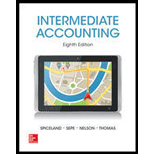
(1)
Earnings per share (EPS): The amount of earnings made available to each common share is referred to as earnings per share. Dilutive securities like convertible bonds, convertible
Use the following formula to determine EPS:
To indicate: The other adjustments required for computation of diluted EPS
(1)
Explanation of Solution
The following are the other adjustments required for computation of diluted EPS:
- Dilutive securities like restricted stock awards, restricted stock units, conversion, and contingent shares increase the potential number of shares.
- If the stock options would be considered while computing diluted EPS, if the share price on that date is less than average market price. This is because exercisable options are assumed to be exercised, and eventually increase the number of shares.
- Additional number of shares would be issued under certain contingent conditions, or occurrence of some situation in future. So, the fulfilled contingent agreement would increase the number of weighted average number of shares while computing diluted EPS.
- While computing diluted EPS, it is assumed that the convertible bonds are converted into common shares. This increases the number of common shares in the denominator, and increases the numerator, earnings available to common shareholders, as after-tax interest which had been avoided due to conversion of bonds, increases net income. This conversion dilutes the EPS.
(2)
To indicate: The reason for not including antidilutive securities in the computation of diluted EPS
(2)
Explanation of Solution
The amount of earnings made available to each common share is referred to as earnings per share (EPS). In the computation of basic EPS, dilutive securities like are convertible bonds, convertible preferred stock, and stock options are not included. But in the computation of diluted EPS, dilutive securities are included, if the effect of the securities is not antidilutive. If the conversion of dilutive securities would not reduce the diluted EPS in comparison to basic EPS, the effect of conversion of securities into common shares is antidilutive. Such securities which have nil effect on dilution of EPS are referred to as antidilutive.
(3)
To prepare: The presentation of basic and diluted EPS for 2013, 2012, and 2011 as reported by Corporation K in its 2013 annual report
(3)
Explanation of Solution
Corporation K would present the basic and diluted earnings per share, in its 2013 annual report, as shown below:
| Earnings per share | 2013 | 2012 | 2011 |
| Basic: | |||
| Earnings per share from continuing operations | $2.12 | $2.04 | $1.90 |
| Earnings per share from discontinued operations | - | (0.01) | (0.05) |
| Earnings per share from disposal of discontinued operations | 0.02 | 0.05 | - |
| Basic earnings per share | $2.24 | $2.08 | $1.95 |
| Diluted: | |||
| Earnings per share from continuing operations | $2.09 | $2.03 | $1.88 |
| Earnings per share from discontinued operations | (0.01) | (0.01) | 0.05 |
| Earnings per share from disposal of discontinued operations | 0.02 | 0.05 | - |
| Diluted earnings per share | $2.10 | $2.07 | $1.93 |
Table (1)
Working Notes:
Compute basic earnings per share from continuing operations in 2013.
Compute basic earnings per share from disposal of discontinued operations in 2013.
Compute total basic earnings per share in 2013.
Compute diluted earnings per share from continuing operations in 2013.
Compute diluted earnings per share from discontinued operations in 2013.
Compute diluted earnings per share from disposal of discontinued operations in 2013.
Compute total diluted earnings per share in 2013.
Compute basic earnings per share from continuing operations in 2012.
Compute basic earnings per share from discontinued operations in 2012.
Compute basic earnings per share from disposal of discontinued operations in 2012.
Compute total basic earnings per share in 2012.
Compute diluted earnings per share from continuing operations in 2012.
Compute diluted earnings per share from discontinued operations in 2012.
Compute diluted earnings per share from disposal of discontinued operations in 2012.
Compute total diluted earnings per share in 2012.
Compute basic earnings per share from continuing operations in 2011.
Compute basic earnings per share from discontinued operations in 2011.
Compute total basic earnings per share in 2011.
Compute diluted earnings per share from continuing operations in 2011.
Compute diluted earnings per share from discontinued operations in 2011.
Compute total diluted earnings per share in 2011.
Want to see more full solutions like this?
Chapter 19 Solutions
INTERMEDIATE ACCOUNTING
- Nicholas Johnson is a single individual. He claims a standard deduction of $13,500. His salary for the year was $156,800. What is his taxable income?arrow_forwardWhat amount should Estefan report as a current liability for advances from customers in its Dec. 31, 2022, balance sheet?arrow_forwardHow many gallons will RZT budget to purchase in August?arrow_forward
- Can you explain the correct methodology to solve this general accounting problem?arrow_forwardHow can I solve this financial accounting problem using the appropriate financial process?arrow_forwardI am trying to find the accurate solution to this general accounting problem with the correct explanation.arrow_forward
- Please help me solve this financial accounting problem with the correct financial process.arrow_forwardDear expDon't solve if you solve with incorrect values then i will give unhelpful .arrow_forwardCan you show me the correct approach to solve this financial accounting problem using suitable standards?arrow_forward

 AccountingAccountingISBN:9781337272094Author:WARREN, Carl S., Reeve, James M., Duchac, Jonathan E.Publisher:Cengage Learning,
AccountingAccountingISBN:9781337272094Author:WARREN, Carl S., Reeve, James M., Duchac, Jonathan E.Publisher:Cengage Learning, Accounting Information SystemsAccountingISBN:9781337619202Author:Hall, James A.Publisher:Cengage Learning,
Accounting Information SystemsAccountingISBN:9781337619202Author:Hall, James A.Publisher:Cengage Learning, Horngren's Cost Accounting: A Managerial Emphasis...AccountingISBN:9780134475585Author:Srikant M. Datar, Madhav V. RajanPublisher:PEARSON
Horngren's Cost Accounting: A Managerial Emphasis...AccountingISBN:9780134475585Author:Srikant M. Datar, Madhav V. RajanPublisher:PEARSON Intermediate AccountingAccountingISBN:9781259722660Author:J. David Spiceland, Mark W. Nelson, Wayne M ThomasPublisher:McGraw-Hill Education
Intermediate AccountingAccountingISBN:9781259722660Author:J. David Spiceland, Mark W. Nelson, Wayne M ThomasPublisher:McGraw-Hill Education Financial and Managerial AccountingAccountingISBN:9781259726705Author:John J Wild, Ken W. Shaw, Barbara Chiappetta Fundamental Accounting PrinciplesPublisher:McGraw-Hill Education
Financial and Managerial AccountingAccountingISBN:9781259726705Author:John J Wild, Ken W. Shaw, Barbara Chiappetta Fundamental Accounting PrinciplesPublisher:McGraw-Hill Education





